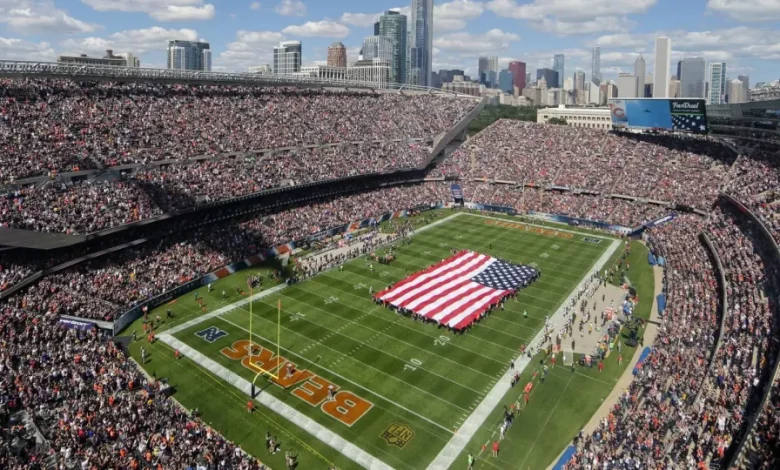The city is desperate to retain the Chicago Bears, and they must decide on a $3.2 billion stadium.

Chicago Bears Face $3.2 Billion Stadium Decision with City Desperate to Keep Team
The Chicago Bears are at a crossroads, with their future in the city hanging in the balance. A looming decision on the fate of the team’s home stadium threatens to reshape the franchise’s legacy and alter the sports landscape of Chicago for generations. The Bears are currently evaluating a potential $3.2 billion stadium project, but this monumental undertaking comes with a set of challenges—financial, logistical, and emotional—that both the team and the city must navigate.
As one of the NFL’s most storied franchises, the Bears’ relationship with the city of Chicago is rich in history. Since 1971, the team has called Soldier Field its home, but the iconic stadium has become increasingly inadequate in accommodating the demands of modern NFL teams and fans. The decision to either renovate Soldier Field, move to a new stadium within Chicago, or relocate altogether will have far-reaching implications, not only for the Bears’ financial future but also for the city’s economy, identity, and its ability to maintain one of the most cherished professional sports franchises in America.
The Bears’ Current Situation
Soldier Field, the Bears’ home for over five decades, has been the subject of criticism for years. Though it remains one of the oldest and most historic stadiums in the NFL, it has also become one of the smallest and least modern. While the stadium underwent a major renovation in 2003, which included the controversial addition of a futuristic seating bowl, the facility still faces numerous shortcomings. The outdated amenities, limited seating capacity, and the lack of advanced features that modern stadiums now boast have led to frustration among both the Bears organization and their fans.
The team’s ownership has long voiced concerns over the stadium’s ability to meet the demands of a modern NFL franchise. The lack of luxury suites, premium seating options, and cutting-edge technology has hindered the Bears’ ability to compete financially with other teams. Additionally, the location of Soldier Field—tucked away in the heart of Grant Park on the edge of Lake Michigan—limits opportunities for expansion and complicates efforts to improve the fan experience. As a result, the Bears have begun to explore the possibility of leaving Soldier Field behind and either renovating the facility or constructing a new stadium in a different location.
The $3.2 billion price tag attached to the new stadium proposal underscores the scale of the decision the Bears are facing. With rising construction costs and the need for a state-of-the-art venue, the Bears will need to secure significant funding for this project. While the franchise has deep pockets, the question remains: should the Bears invest in a new stadium within Chicago, or should they look beyond the city for a more lucrative deal?
The City’s Desire to Keep the Bears
For the city of Chicago, the stakes are just as high. The Bears are not only a beloved sports franchise but also a significant economic driver for the city. Home games generate millions of dollars in revenue from ticket sales, concessions, parking, and merchandise. Additionally, the Bears contribute to the tourism industry, with fans traveling from across the region to attend games. The presence of an NFL team in the city is a point of pride for Chicagoans and is woven into the city’s identity. The potential loss of the Bears would leave a massive void in Chicago’s sports culture.
Mayor Brandon Johnson and the city’s leadership have been vocal about their desire to retain the Bears within the city limits. Johnson’s administration has expressed a commitment to exploring ways to keep the team at Soldier Field, but the city faces several significant challenges. The primary issue is the limited land around Soldier Field for the kind of development needed to make the stadium economically viable in the long term.
While the city could invest in improvements to Soldier Field, the reality is that the stadium’s location presents numerous logistical problems. Grant Park, where Soldier Field is located, is a historic site with stringent zoning laws that restrict development. Any attempt to modernize the stadium on the current site would require navigating a web of political and legal hurdles, including community opposition, environmental concerns, and limited opportunities for expansion. Even with the city’s best efforts, a major renovation would likely fall short of the massive improvements the Bears are seeking.
In addition to the challenges of renovating Soldier Field, the city of Chicago faces a growing competition from other regions eager to lure NFL teams. Cities like Arlington Heights, who have been working with the Bears on plans for a new stadium in the suburbs, are offering enticing financial incentives that would ease the Bears’ financial burden. These cities are eager to secure a professional sports team, recognizing that an NFL franchise can have a substantial economic impact in terms of job creation, tourism, and infrastructure development.
The Stadium Deal: The $3.2 Billion Proposal
The Bears have been negotiating with several potential partners for a new stadium project, with one of the most prominent proposals coming from the suburbs of Arlington Heights. The plan calls for the construction of a state-of-the-art, open-air stadium capable of seating over 60,000 spectators. Designed with a variety of modern amenities, the new stadium would include luxury suites, enhanced fan experiences, and ample space for retail, entertainment, and other revenue-generating activities.
The $3.2 billion cost for the new stadium is steep, but the potential return on investment for the Bears could be substantial. The new venue would allow the Bears to generate additional revenue from luxury seating, naming rights, sponsorships, and other revenue streams that Soldier Field cannot provide. Furthermore, a new stadium in Arlington Heights would provide the team with more room for expansion and development, creating a more vibrant and profitable environment both on game day and year-round.
The proposal includes significant private investment, but the Bears would also be seeking public support, as is common for large-scale sports infrastructure projects. Local governments in Arlington Heights and the surrounding suburbs would likely be asked to contribute to the development costs, either through tax incentives, infrastructure improvements, or direct financial backing. The Bears have already made it clear that a deal of this magnitude requires a public-private partnership, and the team is reportedly in negotiations with local leaders to finalize the terms of the project.
However, the $3.2 billion proposal is not without controversy. Critics argue that using public funds to subsidize such a massive project could divert resources away from other crucial city needs, such as education, housing, and social services. Additionally, some community groups have expressed concerns about the potential displacement of local residents and the impact the stadium’s construction would have on the environment and local infrastructure.
The Financial Implications
The Bears are one of the most valuable franchises in the NFL, with an estimated value of over $5 billion. However, the team’s financial situation is far from straightforward. While the franchise has generated significant revenue through ticket sales, merchandise, and television rights, the Bears have also faced rising operational costs. Their aging stadium has become increasingly difficult to maintain, and the team has been left behind in terms of revenue-generating opportunities compared to other NFL teams with more modern venues.
A new stadium could change that dynamic. The Bears would have the opportunity to increase their revenue streams substantially, from increased ticket prices to the sale of naming rights, sponsorship deals, and enhanced premium seating options. A new stadium would provide the team with the flexibility to create year-round events, such as concerts and other sports-related activities, which would generate additional revenue. The franchise is also eyeing opportunities for the development of surrounding land, which could include hotels, restaurants, and retail outlets—further increasing the financial payoff for the team.
However, the financial burden of such a project would be substantial. Even with private investment and public contributions, the Bears would need to ensure that the stadium is financially sustainable in the long term. Any failure to generate enough revenue could put the team in a difficult position, especially if they are burdened with the costs of financing such a massive construction project.
The Emotional and Cultural Impact
Beyond the financial and logistical considerations, the decision about where the Bears will play their home games has a deep emotional and cultural significance for the city of Chicago. The Bears have been an integral part of the city’s identity for over 100 years, and their departure—especially to a suburban location—could leave a lasting impact on the city’s sense of pride and community.
For many Chicagoans, Soldier Field is not just a stadium; it’s a symbol of the city’s football legacy. The Bears’ rich history, from their early days in the NFL to their Super Bowl victory in 1985, is intertwined with the story of Soldier Field. Moving the team to the suburbs, away from the heart of the city, would represent a significant shift in the Bears’ relationship with their fan base.
The loss of the Bears would also impact the local economy. The team’s home games bring millions of dollars in tourism revenue, and many businesses in the area rely on game-day traffic. A move to the suburbs could cause a ripple effect, potentially leading to the loss of jobs and revenue in Chicago’s downtown area.
The Decision Ahead
The Chicago Bears face a monumental decision regarding the future of their home stadium. Whether they choose to remain at Soldier Field, pursue a renovation, or move to a new stadium in the suburbs, the decision will have far-reaching consequences for both the team and the city. The potential $3.2 billion price tag for a new stadium underscores the stakes of the decision, as the Bears must balance financial viability with emotional and cultural considerations.
For the city of Chicago, losing the Bears would be a blow to its identity and its economy, but it is not yet clear whether the city can meet the Bears’ demands for a modern, profitable stadium. The coming months will likely be filled with negotiations, debates, and public discourse as both the Bears and the city’s leadership work to determine the future of one of the NFL’s most storied franchises.









